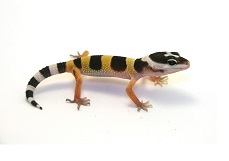Common Leopard Gecko (Eublepharis macularius)
Description: Leopard geckos are small lizards that derive their name from their spotted coloration. Hatchlings are on average 2.8 to 3.9 inches in length and weigh about 2 to 5 grams. Adult females are about 7.1 to 7.9 inches in length and weigh about 50 to 70 grams, while adult male geckos are about 7.9 to 11.0 inches in length and weigh about 60 to 80 grams. Unlike many other geckos, but like other Eublepharids, their toes do not have adhesive lamellae, so they cannot climb smooth vertical walls.
Habitat: Leopard geckos inhabit arid and semi-arid areas with sparse vegetation and clay or sandy soils, as well as rocky habitat where crevices can be used as shelter. They reportedly avoid areas where the primary substrate is sand. Leopard geckos may also be found in arid forests of Nepal and Pakistan, and are reported to shelter under loose bark of trees in these environments. Winter temperatures within the range of the leopard gecko can be quite low, below 50 °F, forcing the animals underground into semi-hibernation, called brumation, living on fat reserves.
Range: The native habitat of the leopard gecko includes the rocky, dry grassland, and desert regions of south-Asian Afghanistan, Pakistan, north-west India, western Nepal, and some parts of Iran. They have been introduced into the United States in several states.
Diet: Leopard geckos are opportunistic predators that eat a variety of prey items. Invertebrates are presumed to make up the majority of wild geckos' diets, but in captivity they will also eat small vertebrate prey if given the opportunity, including mouse pups and even hatchling leopard geckos. Breeders of captive leopard geckos report that sufficiently fed leopard geckos will not cannibalize young, and that the cannibalistic behavior appears to take place only in poorly fed animals.
Reproduction: Leopard geckos typically breed in the summer. Females can store sperm over the course of their breeding season, and produce up to three clutches from one or two copulations. Females can lay about six to eight clutches of two eggs; eggs are laid approximately 21 to 28 days after mating. The average amount of time it takes for a newborn to hatch is anywhere between 35 and 89 days, although it is usually closer to the latter. Baby leopard geckos will have an "egg tooth", a calcareous tip at the end of its snout to help break their egg shell. Their "egg tooth" will fall off within one to two days. In addition to this, their skin will usually shed within 24 hours of hatching. The leopard gecko hatchling will not be able to eat until after the first shedding.
Leopard geckos are also known to have temperature-dependent sex determination. Embryos incubated in predominantly cool temperatures 79–84 °F or very warm temperatures 93–95 °F will develop as females, while embryos incubated at intermediate temperatures 88–91 °F will develop as male. Determination of sex is believed to be set during the first two weeks of incubation. Females born in the higher temperatures differed from those who were born in the lower temperatures hormonally and behaviorally. Those born in the warmer temperatures expressed more aggressive behavior. These are known as "hot females" and are often determined to be infertile.
Status: Listed as Least Concern in view of its wide distribution, presumed large population, and because it is unlikely to be declining.
»» Kingdom: Animalia - Animals
»» Phylum: Chordata - Chordates
»» Subphylum: Vertebrata - Vertebrates
»» Class: Reptilia - Reptiles
»» Order: Squamata - Lizards
»» Family: Gekkonidae - Geckos
»» Genus: Eublepharis
»» Species: Eublepharis macularius - Common Leopard Gecko
»» Subspecies: None
This article uses material from the Wikipedia article "Leopard Gecko", which is released under the Creative Commons Attribution-Share-Alike License 3.0. Content may have been omitted from the original, but no content has been changed or extended.
|








